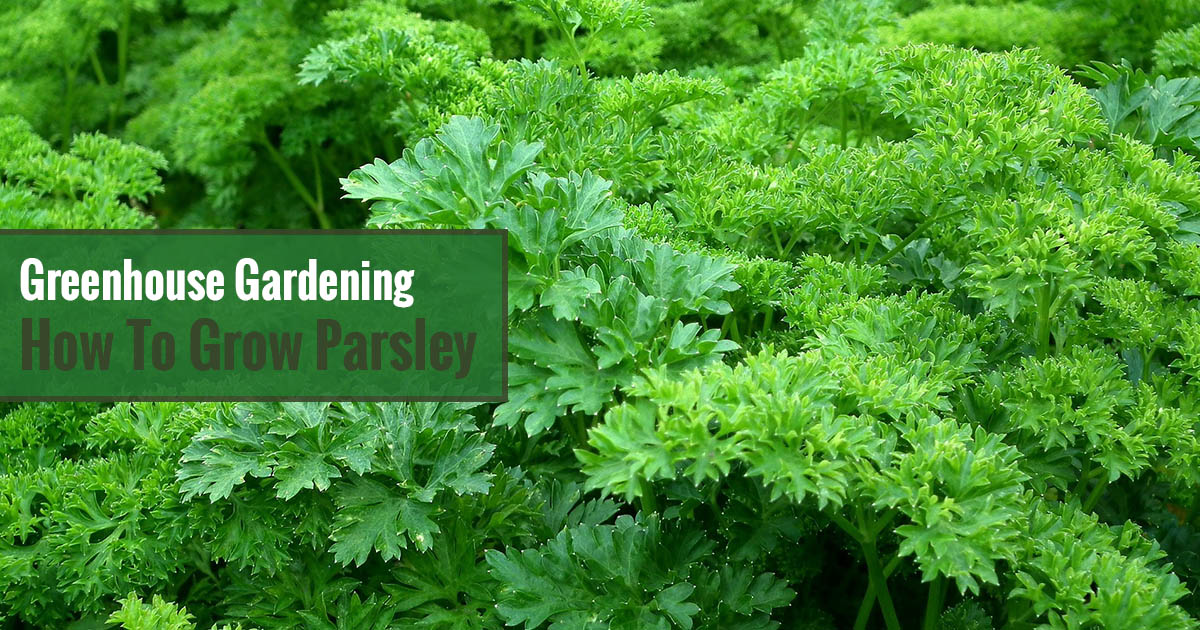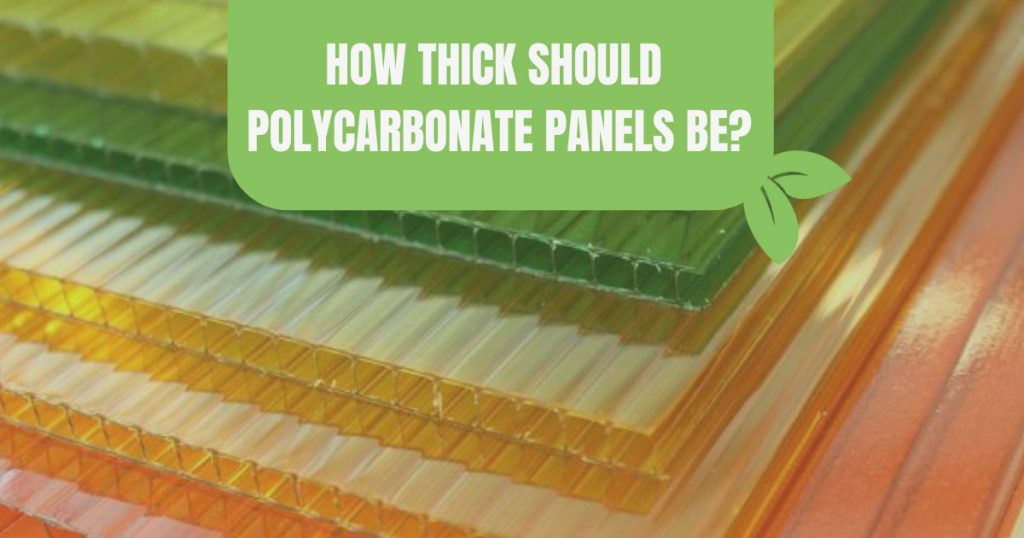


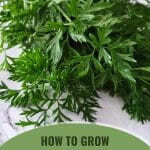



If there’s one staple you should have growing in your greenhouse, it’s parsley. Parsley is a classic aromatic herb that is easy to grow, readily available, and relatively care-free. You can grow parsley in the greenhouse year-round, ensuring that you have a fresh supply of its delicious and versatile green sprigs at all times.
There are many ways to go about growing parsley in a greenhouse. All you really need to get started is some bare soil (a raised bed or a pot will do) and seeds or nursery starts. The most difficult part is getting parsley seeds to germinate, but we’ve got a few tricks that will be sure to help you out.
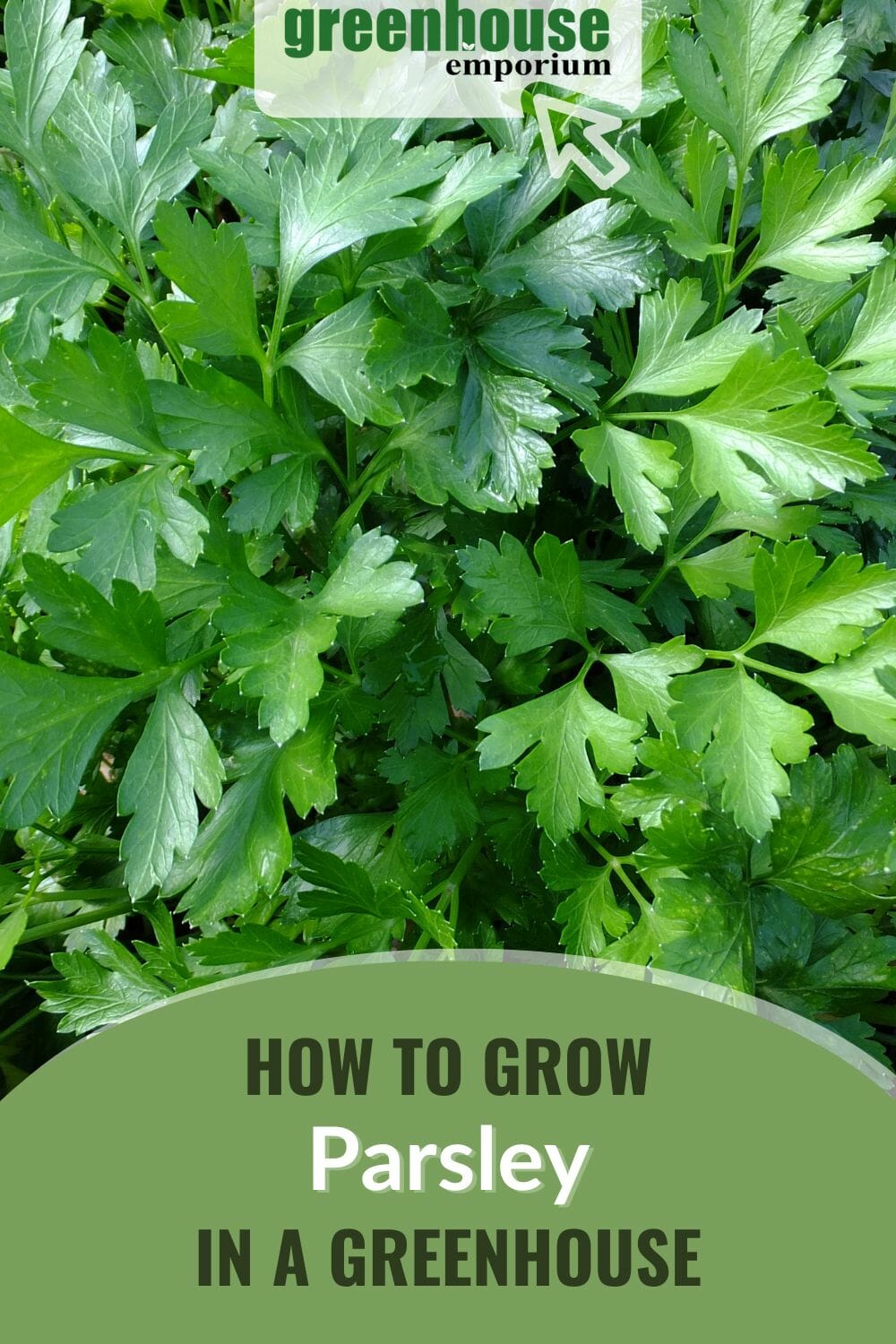
If you’ve been struggling with growing parsley, or are wanting to add this delicious herb to your greenhouse garden, there’s no better time to get started than the present. To help you get started, we’ve condensed all of the best parsley-growing advice into one guide. So what are you waiting for?
Quick overview of growing parsley in a greenhouse
- Type: Warm-season crop
- Time from seed to harvest: 60-70 days
- Germination temp: Best at 70°F (as low as 50°F)
- Time until first emergence: 2-4 weeks
- Best temp to grow: 50-80°F
- Height: 8-14 in
- Spread: 6-8 in
- Light: Full sun (6-8h)
- Grow from seed: 1/2 in deep, 6 in apart
- Companions: Asparagus, corn, tomatoes, beans, apples, pear, rose, pepper, kale, broccoli, cabbage, chives
- Keep away from: Lettuce, carrots, onions, garlic, mint
Popular parsley varieties for greenhouses
Parsley has been cultivated for thousands of years, so it’s only natural that there’s many varieties or cultivars to choose from. While that may seem intimidating, your local nursery will likely only have a few to choose from, making the choice a bit easier.
If you want to grow a particular, more rare variety of parsley, you’ll likely have to go seed hunting online.
Before you rush to go buy your parsley plants or seeds, it’s helpful to know that there are three main types of parsley to choose from: curly leaf parsley, broad-leaf parsley, and root parsley. We’ll go over the main characteristics of each type below, as well as our favorite parsley varieties to grow in the greenhouse.
Curly leaf parsley
Curly leaf parsley is a great addition to any cuisine and adds a sumptuous deep green splash of color to flower and vegetable beds alike. As the name suggests, this type of parsley is characterized by frilly, dark green leaves on ribbed stems. It’s usually used as a garnish or minced and combined with salads.
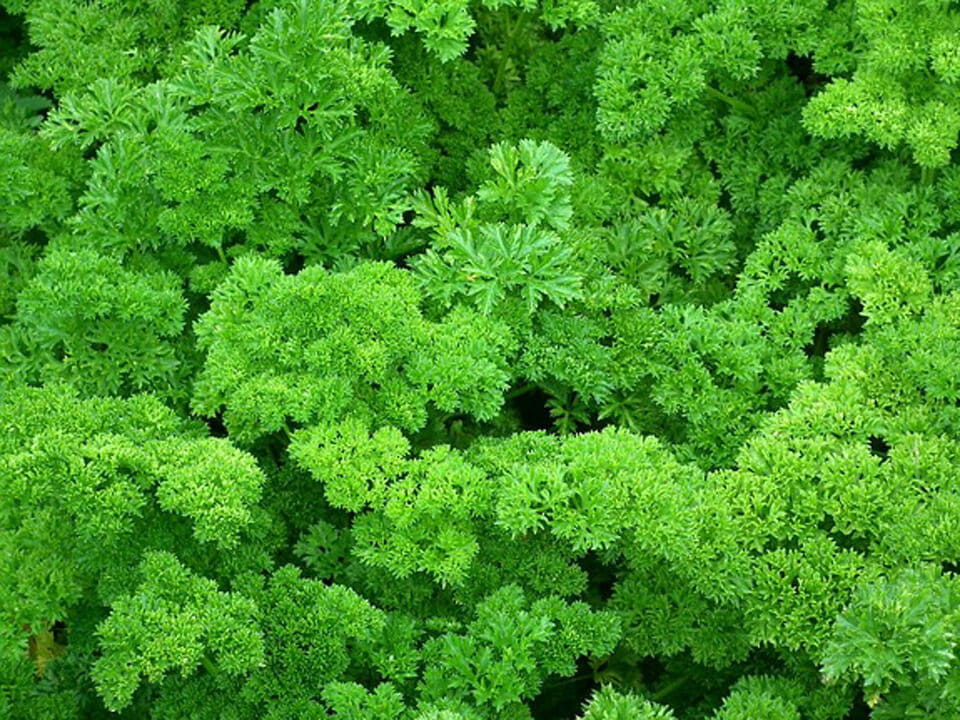
Broad-leaf parsley
Broad-leaf parsley (also known as flat-leaf parsley or Italian parsley) includes several varieties that appear similar to cilantro but taste deliciously sweet and powerful. To tell the two apart, look closely at the leaves: cilantro leaves tend to be rounded, while parsley leaves are more pointed. If you’re still unsure, taste or smell the leaves. Parsley should have an herbal taste, while cilantro is more citrusy (for some people it even tastes like soap).
Broad-leaf parsley is a great choice to use with cooked recipes. It’s often used to add flavoring to soups and casseroles.
Root parsley
Root parsley leaves and roots are often used in soups, casseroles, and salads. Root parsley appears very similar to broad-leaf parsley above the soil, though the leaves are tougher and stronger in flavor. The root is white in color and similar in appearance to a parsnip, but with a milder taste, making it a great alternative to more common root vegetables.
How to plant parsley in a greenhouse
Since parsley is a staple in the kitchen, it makes sense that it would also be a staple in the greenhouse. However, too many gardeners forget about this humble herb in the search for exciting and exotic crops to grow. But you don’t need much space to grow parsley, a spot of bare soil or a pot is plenty!
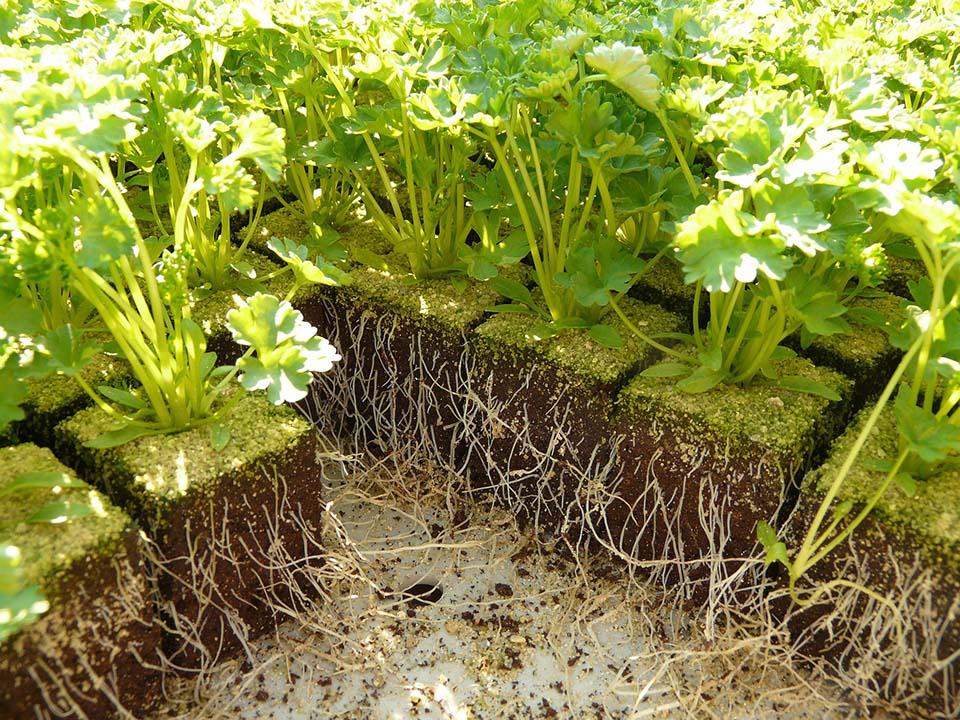
How to start parsley from seed
Parsley also has a bit of a reputation for being difficult to grow from seed. With a few simple tricks, however, you should have no problem getting your parsley seeds to germinate with consistency!
Before you even plant parsley seeds, it’s recommended to prime them. There are a few ways to do this, the simplest is to soak the seeds in luke-warm water for 8-24 hours before planting. This will soften up the hard exterior seed coating and speed up germination. You can also achieve similar results by rinsing the seeds in a mesh strainer under hot water for a few minutes.
Once the seeds are moistened, gather up your seed starting supplies: parsley seeds, seed-starting soil, and a seeding tray or a few empty pots. Fill the tray or pots with soil, gently tamp it down, and place a few seeds in each cell or pot. Barely cover the seeds with soil, water, and cover with a plastic dome to lock in moisture. Parsley seeds can take 2-4 weeks to germinate, so make sure to keep the soil moist during this time.
An alternative method, which takes a little more effort but has stellar results, is priming the seeds in a plastic bag. Place the seeds on a moist paper towel, fold it up, and put it in a plastic bag. Place the bag in a warm spot (between 50-80°F, but results are best at around 70°F). Check the seeds every day, and plant them in soil as soon as you see any of them sprout white roots.
How to transplant parsley into raised beds or the ground
Once you’ve sprouted your parsley seeds or bought some starts from a nursery, it’s time to plant them in the greenhouse. Growing parsley in a raised bed (or straight in the ground, depending on your greenhouse setup) is a great option if you’re either looking to produce a lot of parsley, or just want to fill in some bare spots between other plants. Parsley makes a great companion for many plants such as tomatoes and peppers.
To plant parsley in a raised bed, simply dig a hole slightly bigger than the pot/cell, and gently transplant the seedling. Water generously, then wait a few days before watering again. Make sure that you space parsley plants about 8 inches apart for best results.
For an extra boost, amend the soil before planting with some well-composted manure or compost.
How to grow parsley in pots
If you have a smaller greenhouse, or just want to grow a few individual parsley plants, a great option is to grow parsley in pots! You can choose almost any kind of container, as long as it’s at least 8 inches in diameter. Ceramic pots, hanging pots, or plastic pots are all great options.
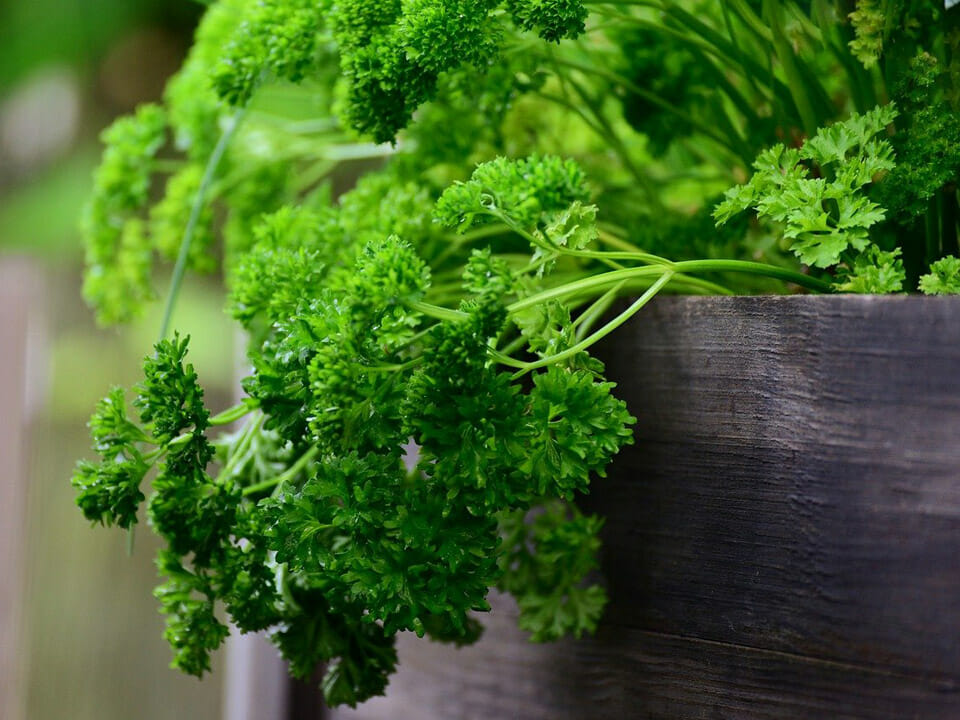
To plant parsley in a pot, start by filling the pot with a generous amount of soil mix, mixing in compost if you have some on hand. Plant your parsley seedling by making a hole just big enough for the root ball and cover the exposed roots with soil. Water thoroughly.
For smaller pots, it’s best to grow just a single parsley plant per pot. A bigger pot, for example one that’s at least 12 inches in diameter, can accommodate 2-3 plants.
How to care for parsley in a greenhouse
Once established, parsley is incredibly easy to grow and doesn’t require much care. But like all living things, it needs its basic needs met, or it can become plagued by disease or pests. Keep reading to learn all about keeping your parsley plants happy!
How much do I need to water my greenhouse-grown parsley?
Before and right after germination, water the soil regularly to keep it moist. This is super important until the seeds germinate, as they are small and can dry out quickly. Once germinated, you can switch to a less frequent watering schedule.
However, you may need to water parsley plants more often during the summer months in order to ensure that the plants don’t dry out. Likewise, soil in pots tends to dry out quicker than in raised beds or in the ground, so you may need to water those more often.
What soil is best for parsley?
Parsley grows well in a mix of different soil varieties. Overall, the soil should be well-draining and filled with rich organic material. The optimal pH is about 6.0 to 7.0, though it will survive in less than ideal conditions.
You can prepare the soil of a raised bed by adding organic material such as manure or compost, ensuring that your parsley plants will be off to a great start.
How much light does parsley require?
Parsley is a warm-season crop and thrives abundantly in full sunlight with at least 6 to 8 hours every day. To protect from extreme heat in summer, you can add a shade cover, but make sure it’s one that still lets in some light.
If growing parsley in the winter, you may need to supplement with a grow light for best results.
Common problems with growing parsley in a greenhouse
Parsley is seldom disturbed by pests and diseases in the greenhouse. You may see some random caterpillars on your parsley plants, but you can simply pick them off as you see them. Similarly, you can prevent most diseases by simply maintaining plenty of airflow in your greenhouse.
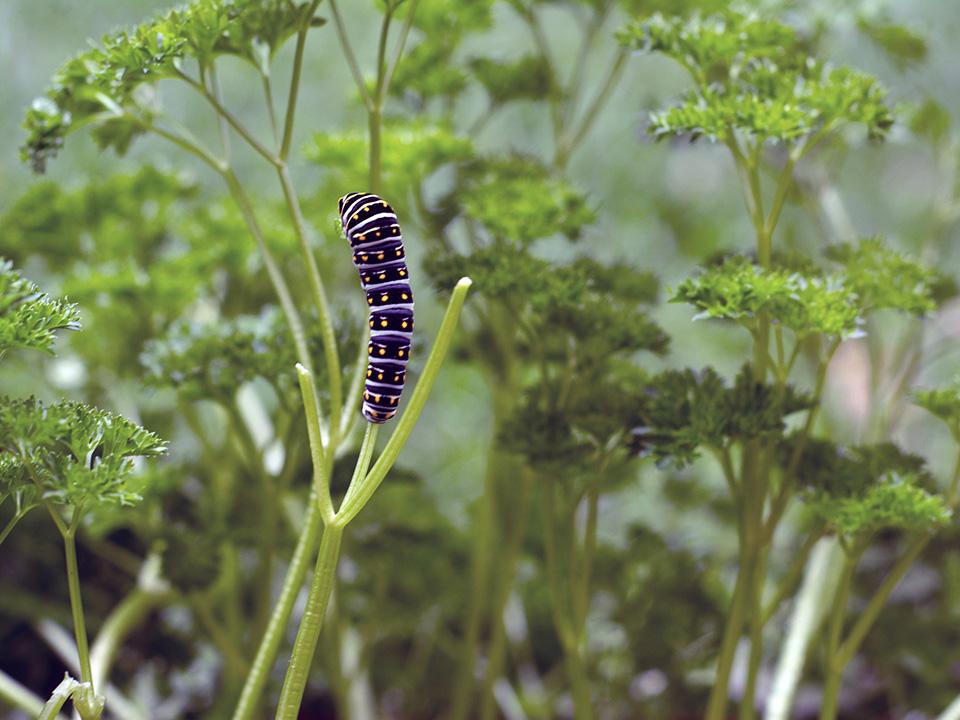
That said, some diseases to look out for include leaf spot, stem rot, and root rot. Symptoms of leaf spot include tan or brown spots on the leaves. Pick off affected leaves and reduce humidity levels by increasing airflow or allowing the soil to dry out. Stem and root rot, on the other hand, are harder to spot early on, and usually result in dead or dying plants. Remove infected plants to prevent the disease from spreading.
Besides caterpillars, keep an eye out for carrot flies and the larvae of black swallowtail and celery flies. Planting parsley in semi-shade lessens pest pressure and helps discourage carrot flies. It has the added benefit of reducing the chance that a parsley plant bolts prematurely.
How to harvest your greenhouse parsley
In the greenhouse, parsley matures 10 to 12 weeks after planting, at which point you can start harvesting it. Simply pinch off individual branches as you need them, leaving at least 30% of the green leaves so the plant can continue to photosynthesize and keep growing.
Start by pinching the lower, more mature leaves, working up the stem as the plant grows. You can keep harvesting a single parsley plant like this for many months!
Tips for storing parsley
Parsley loses some of its taste when dehydrated or refrigerated, and is best when picked fresh from the greenhouse garden. If you need to harvest a bunch of parsley, however, for example if you’re expecting a hard freeze, you can keep it refrigerated for several weeks in a glass of water with a plastic bag over it to keep in humidity.
To dry parsley for long-term storage, simply hang the harvested stems upside down in bundles in a dark, warm, well-ventilated place, or spread them out and dehydrate them in the oven at 100-110°F. Dehydrated parsley can be saved ground or whole in a sealed jar. It’s perfect for cooking and using in spice mixes, such as homemade ranch seasoning!
If you want to freeze parsley, store raw stems and leaves in plastic bags inside your freezer. Parsley preserved by drying or freezing should be good to use for 1 year.
FAQs about growing parsley in a greenhouse
What do parsley seeds look like?
Parsley seeds are small and look very similar to carrot and celery seeds, in fact, they’re all in the same family! These tiny seeds are light brown or tan in color, are slightly tear-drop-shaped, and have rough ridges running from end to end.
How long does parsley take to grow?
If you’re growing parsley from seed, it can take 60-70 days until you can harvest it. You should be able to see the first growth after 2-4 weeks.
Can greenhouse-grown parsley be transplanted?
Contrary to popular belief, parsley seedlings can be transplanted without a problem. To reduce the risk of transplant shock, make sure the soil is moist, and be gentle so as not to overly disturb the roots. Some people recommend using peat pots so you can transplant with the pot and all, but parsley roots might have trouble growing through the peat.

